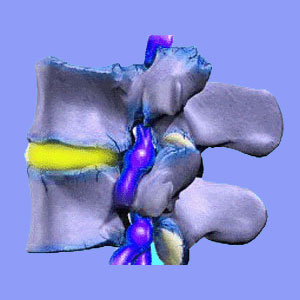
Sciatica nerve compression describes a lower back and leg pain syndrome which is blamed on impingement of some neurological structure within the spine. The varieties of nerve impingement leading to sciatica can be varied and many are typically misdiagnosed in the majority of patients. This is precisely why the “average” sciatica sufferer never finds lasting or complete relief from their torturous pain.
This article details some of the suspected ways in which compressed nerves might cause or contribute to sciatic nerve pain. However, we will spend equal time debunking many myths, when it comes to structural neurological compression being the only possible cause of chronic sciatica.
Nerve Compression Possibilities
There are many compressive neuropathy possibilities that can cause sciatica. The most commonly diagnosed compressive neuropathy is sciatica from a pinched nerve (a pinched spinal nerve root, actually). This generally is thought to occur from a herniated disc or osteophyte complex that is narrowing the neuroforaminal space and impinging on the nerve root. This type of neurological compression can also occur from other spinal conditions, such as spondylolisthesis, scoliosis, hyperlordosis and hyperkyphosis.
The next most commonly diagnosed cause of sciatica is spinal stenosis from any of the above sources impinging on the actual spinal cord itself and enacting sciatic nerve pain. This version of central spinal stenosis can enact a plethora of terrible symptoms, with sciatica being just one of the most common.
Finally, the sciatic nerve itself can be compressed by a variety of mostly muscular issues, such as in the case of piriformis syndrome.
Sciatica Nerve Compression Realities
A compressed neurological tissue will simply stop signaling completely after a time. This is proven medical science. Why then do so many patients receive the diagnosis of nerve compression, yet continue to have terrible pain for months, years or decades?
Why do these same patients have pain, and other symptoms, in areas of their bodies that are not even served by the suspected compressed nerves?
Most of all, why do the endless treatments, injections and surgeries fail to produce positive curative results?
These are all vital questions to consider.
While there is no universal answer that applies to all, the most logical and commonly applicable explanation is simple misdiagnosis of the suspected causative process: i.e. the compressed nerve. Many nerves do not suffer any compression and may simply be in close proximity to potentially impinging structures, while in other cases, simple contact or displacement may take place, but no pathological compression. Now, the reasons why so many patients suffer chronic sciatic nerve torture become far more focused.
Sciatica Nerve Compression Help
If you have been diagnosed with any type of neurological compression (pinched nerve or stenosis diagnoses) then you should get better with appropriate treatment. If your doctor can recognize a source of pain, but cannot fix it, then there is an excellent chance that the anatomical findings are coincidental to the pain experienced.
This was my own personal hell for 18 long years of battling what I thought to be unbearable back pain from 2 lumbar herniated discs. Well, the diagnosis was incorrect all along. I am more than a bit bitter that I spent 18 years of gut-wrenching suffering, practically all my disposable income and a world of worry just to find this out.
Although diagnosed as a compressed nerve tissue concern in the overwhelming majority of sufferers, chronic sciatica is sometimes not a structurally-based condition. In fact, most nerve compression models do not make sense for the diversity of symptoms experienced.
Some of these misdiagnosed sciatica pain syndromes turn out to be simple oxygen deprivation issues. Since medical science does not universally embrace the mindbody mechanism in the production of pain, doctors and complementary therapists are at a loss as to how to treat these patients successfully. Poor statistics for sciatica cures clearly demonstrate this as a fact.
Luckily, Descartes is long dead and some doctors have realized the limitations of the Cartesian philosophy. This trend is supported by the successful application of risk-free and holistic knowledge therapy practices by many famous physicians, such as Dr. John E. Sarno of the NYU Medical Center / Rusk Institute of Rehabilitation Medicine, in New York City.





